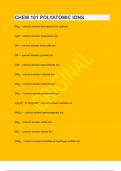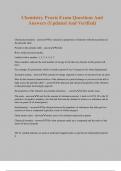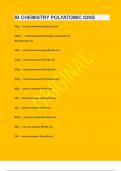Polyatomic ions verified - Study guides, Class notes & Summaries
Looking for the best study guides, study notes and summaries about Polyatomic ions verified? On this page you'll find 28 study documents about Polyatomic ions verified.
Page 3 out of 28 results
Sort by

-
POLYATOMIC IONS|UPDATED&VERIFIED|100% SOLVED|GUARANTEED SUCCESS
- Exam (elaborations) • 2 pages • 2023
-
Available in package deal
-
- $12.49
- + learn more
Study POLYATOMIC IONS Share In-class activity Classic Live Checkpoint Self-study activity Flashcards Learn Test Match perchlorate (ClO₄)⁻ 1 / 23 Profile Picture Created by Badman892 Teacher Biggs AP Chemistry Terms in this set (23) Original

-
POLYATOMIC IONS|UPDATED&VERIFIED|100% SOLVED|GUARANTEED SUCCESS
- Exam (elaborations) • 2 pages • 2023
-
Available in package deal
-
- $13.89
- + learn more
NH₄⁺ Ammonium C₂H₃O₂⁻ Acetate CO₃²⁻ Carbonate HCO₃⁻ Hydrogen Carbonate (bicarbonate) CrO₄²⁻ Chromate Cr₂O₇²⁻ Dichromate CN⁻ Cyanide OH⁻ Hydroxide NO₃⁻ Nitrate NO₂⁻ Nitrite MnO₄⁻ Permanganate PO₄³⁻ Phosphate H₂PO₄⁻ Dihydrogen Phosphate SO₄²⁻ Sulfate SO₃²⁻ Sulfite ClO⁻ Hypochlorite ClO₂⁻ Chlorite...

-
14 POLYATOMIC IONS|UPDATED&VERIFIED|100% SOLVED|GUARANTEED SUCCESS
- Exam (elaborations) • 2 pages • 2023
-
Available in package deal
-
- $12.99
- + learn more
Chromate CrO₄⁻² Ammonium NH₄⁺¹ Acetate C₂H₃O₂⁻¹ Sulfate SO₄⁻² Nitrate NO₃⁻¹ Sulfite SO₃⁻² Nitrite NO₂⁻¹ Chlorate ClO₃⁻¹ Carbonate CO₃⁻² Hydroxide OH⁻¹

-
CHEM 101 POLYATOMIC IONS|UPDATED&VERIFIED|100% SOLVED|GUARANTEED SUCCESS
- Exam (elaborations) • 2 pages • 2023
-
Available in package deal
-
- $12.99
- + learn more
NH₄⁺ Ammonium ion (cation) H₃O⁺ Hydronium ion OH⁻ hydroxide ion CN⁻ cyanide ion ClO⁻ hypochlorite ion ClO₂⁻ chlorite ion ClO₃⁻ chlorate ion ClO₄⁻ perchlorate ion C₂H₃O₂⁻ or CH₃COO⁻ acetate ion MnO₄⁻ permanganate ion NO₂⁻ nitrite ion NO₃⁻ nitrate ion HSO₄⁻ bisulfate or hydrogen sulfate ion HCO₃⁻ bicarbonate or hydrogen carbonate ion ...

-
ABCTE Biology Terms Exam 143 Questions with Verified Answers,100% CORRECT
- Exam (elaborations) • 11 pages • 2023
-
Available in package deal
-
- $11.99
- + learn more
ABCTE Biology Terms Exam 143 Questions with Verified Answers Acidic solution - CORRECT ANSWER contains more hydrogen ions than hydroxide ions basic solution - CORRECT ANSWER contains more hydroxide ions than hydrogen ions colligative properties - CORRECT ANSWER properties of a solution that depend only on the number of particles dissolved in it, not the properties of the particles themselves. The main ones are boiling point elevation and freezing point depression. boiling point eleva...

-
Chemistry Praxis Exam Questions And Answers (Updated And Verified)
- Exam (elaborations) • 7 pages • 2024
-
- $11.49
- + learn more
Chemistry Praxis Exam Questions And Answers (Updated And Verified) Chemical periodicity - answerThe variation in properties of elements with their positions in the periodic table Periods in the periodic table - answerPeriods: Rows which run horizontally. Labeled with a number: 1, 2, 3, 4, 5, 6, 7. These numbers indicate the total number of energy levels that any element in this period will have. For example, K (potassium) which is found in period 4, has 4 energy levels when diagrammed. ...

-
Chapter 6 Chemistry Complete And Verified
- Exam (elaborations) • 6 pages • 2024
-
Available in package deal
-
- $10.27
- + learn more
Chapter 6 Chemistry Complete And Verified Chemical Bonds Chemical bonds are formed through the mutual electrical attraction between the nuclei and valence electrons of different atoms. This attraction binds the atoms together, forming a chemical bond. Types of Chemical Bonds Ionic bonding occurs when there is an electrical attraction between large numbers of cations and anions. Covalent bonding, on the other hand, results from the sharing of electron pairs between two atoms. Pola...

Did you know that on average a seller on Stuvia earns $82 per month selling study resources? Hmm, hint, hint. Discover all about earning on Stuvia



